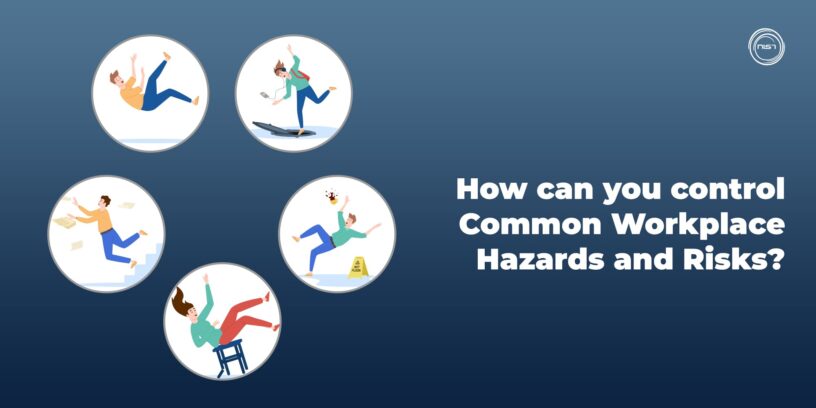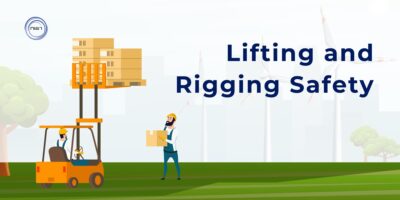Workplace Hazards:
There is no denying that there is some hazard in every workplace, especially if it involves machinery or chemicals that are used by workers on a daily basis without proper safety precautions being taken beforehand, and this can cause serious harm to the employee. Working in an unsafe workplace can be a very dangerous thing. Every day, people are injured or killed in the workplace due to the various hazards that are present. There are many risks, both physical and chemical, that are present in the workplace, and it is important for employees to be aware of them and take appropriate measures to prevent themselves from being injured or harmed. This blog will discuss the various ways in which employees can handle hazards and risks at work.
According to the Occupational Health and Safety Administration, some of the most common work-related injuries are sprains and strains, falls, burns, carpal tunnel syndrome, stress-related injuries, and neck and back injuries. When working with equipment, it is important to be aware of how to protect yourself from static discharge and how to avoid machine-related injuries.
What is workplace safety?
Workplace Safety is the process of making sure all workers have access to safe working conditions and procedures that protect them from harm at work so they can do their jobs safely and productively.
Since industrial and construction work can have an impact on your overall health and safety, you must be prepared to handle the common hazards and risks. It’s time to look at work hazards and risks. In industrial and construction activity, these hazards and risks are more prevalent and severe. Construction sites, factories, warehouses, and manufacturing plants, to name a few, can all be hazardous workplaces for workers.
Is your workplace safe?
When working in the construction and industrial environments, you must take common safety precautions and protect yourself from potential dangers. If you are responsible for workers in the workplace, you should learn how to handle the common workplace hazards and risks and keep them to a minimum to prevent accidents or injuries.
If your workplace is not safe, there are some questions you should ask yourself:
- Are you safe?
- Are your co-workers safe?
- Do you know if there are chemicals in your work area that you are exposing yourself to?
- Can you keep you and your colleagues safe at work?
- Can you reduce the number of accidents?
- Is your workplace clean?
- Do you have the right equipment to do your job?
- Do you understand the workplace risks and how you can minimize them?
- Can you handle dangerous situations?
- Do you know how to reduce accidents?
- Are you prepared for the riskiest situations that may happen at your workplace?
- Can you cope with accidents?
- How well do you handle dangerous situations?
- Are you aware of the regulations?
- Do you have the right training?
In the end, the best way to find out if your workplace is safe is to work on it until it’s safe. This might seem like a lot of work, but it’s the safest and most efficient way to ensure that your workplace is as safe as possible.
While some workplace hazards can be controlled through regular training, some workplace hazards, such as radiation and asbestos, can cause injury or illness or pose a health threat. Even if a workplace is managed by a professional and properly trained, the employer may be responsible for keeping the workplace free of radiation or asbestos exposure. An effective safety training method helps in:
- Identifying hazards and risks
- Reducing hazards, risks, etc. and controlling them
- Preparing a risk assessment
- Providing regular risk assessments to managers
- Having regular risk assessments carried out by workers themselves
- Monitoring and controlling the work environment
- Managing workers safely
The Occupational Safety and Health Administration (OSHA) has been put in place to make sure that workers and their employers adhere to specific safety standards to reduce the likelihood of accidents and injuries. The main aim of any employer is to keep the workplace safe for the workers and for the public to have a safe environment in which to work and visit.
As mentioned earlier, hazards and risks are more frequent and more severe in industrial and construction work. To stay safe in your workplace, you need to be able to handle risks and hazards effectively when they arise.
Safety equipment and practices used by employees who work in hazardous environments:
There is a wide range of protective equipment available for industrial employees that can help them protect themselves from occupational hazards and risks, such as respiratory protection equipment, fall protection systems, helmets, hearing protection and eye protection, first aid kits, gloves, and personal protective clothing, including coveralls, safety boots, and dust respirators.
If your job requires heavy lifting, or pushing or pulling materials, then you need to know how to properly use a tool belt, harness, or other safety device while working at heights, using machinery, or handling heavy loads. Certain hazardous materials should have warning labels, safety signs, and other types of safety information posted.
Steps to avoid occupational risks and hazards:
- Maintain a safe workplace so your workers can remain confident about their jobs
- Have your workers understand the rules and regulations of the workplace and follow them
- Follow strict protocols when handling hazardous materials
- Provide workplace safety training for your workers, including proper handling, use, and storage of hazardous materials
- Protect workers from electrical shock
- Maintain a safe working environment. Keep walkways well lit and free of hazards
- Workers should also have a place to cool off and take breaks, should it get hot or cold
- Keep workplaces clean and free of potential contaminants, such as toxic chemicals or airborne particles
- Conduct regular inspections of workplace areas, including equipment and materials, to ensure that your workers are not exposed to potential hazards on the job
- Workers must always wear a safety helmet, hard hat, safety boots, and proper clothing
- All workers should use only the most appropriate equipment for the job and follow the instructions
- Safety meetings must be held regularly to train workers
- Workers should be informed of potential hazards and the risk of them
Common Hazards:
The hazards at workplaces are quite different from one another, and one has to be aware of their occurrence. To avoid them, it is essential to make the employer aware of the dangers so that they can be minimised or completely avoided. The following list, though not comprehensive, does provide a basic idea of some of the most common hazards and risks that employees are exposed to in industries, as well as tips on how to recognise them and minimise your exposure to them.
The following are some of the most common hazards at workplaces and the steps to avoid them.
Cuts:
It is always best to use protective gear when handling sharp and dangerous objects. Any open cuts should be cleaned and treated to avoid complications.
Loss of sight:
Every day, the eyes are prone to injuries. If an employee is handling any hazardous material that can damage the eyes, they should always wear eye protection. The workplace must be monitored to ensure that the employee is always wearing eye protection.
Heat Stress:
In the industrial and construction environments, one of the significant hazards is heat, and the most serious type is heat stroke. The risk of a heat stroke or heat rash is higher during the hottest parts of the day. In industrial and construction work, you are exposed to the risk of having a heat rash or a heat stroke.
When working in the industrial or construction environment, you must have a plan to reduce your exposure to high heat, cold, humidity, and wetness. To avoid heat stress and heat rash, you must be prepared. The first step in reducing a worker’s exposure to heat is to know the dangers of working in a hot environment and how they can affect your safety and health!
Slips, Trips, Fall, and Injuries:
Slips, trips, and falls injuries are one of the most commonly overlooked and unmonitored workplace hazards. Slips, trips, falls, overexertion, body responses, and contact with objects and equipment account for more than 84 percent of non-fatal injuries necessitating days off work. Check for dangers in the workplace and rectify or remove them. If you see or hear something that is harmful or odd, report it right away. Ensure that your personnel are aware of what to do if they come into such situations on the job, and provide proper safety training.
Hazardous chemicals:
All hazardous substances, including any chemicals that are handled, must be marked and be stored in approved containers. Wash your hands after using any potentially toxic chemicals. Flammable chemicals should be kept in a cool, dry place away from heat.
Lift accidents:
Employees working at high places should always be careful while using the different types of lifts available. These are known as dangerous machines. Always make sure that safety precautions have been taken.
Fire:
The workplace must be checked for fire before and after every work shift. If a fire does occur, the employees should wear suitable personal protection and ensure that they move out of the reach of the fire or flames.
Safety Rules:
The health and safety legislation or the regulatory standards have to be followed by employers. Also, employers has to make sure that they have implemented health and safety regulations and standards. The guidelines and regulations can vary from one workplace to another and from one country to another.
There are some other health and safety guidelines that are followed in the workplace, which can be followed for a safer working environment.
The following are some safety rules that should be followed by every worker:
- Wear personal protective equipment such as hard hats, eye protection, safety glasses, ear plugs, boots or shoes, gloves, etc.
- All hazardous substances, including any chemicals that are handled must be marked.
- All workplace accidents must be reported to the proper authorities
- The employees should make sure that the workplace is free of any harmful materials and substances
- Any type of waste product must be disposed of in the proper manner
- The work of the employees must be carried out in a safe environment
- All the employees must have adequate safety training
- All the employees are trained to be aware of the risks and hazards, and then the safety instructions must be followed in every aspect
- The safety programs in place must be implemented properly
- All the employees are to be given regular health check-ups to ensure their safety and well-being
- The employer must be made aware of the workplace standards.
- The employees should always wear the necessary and adequate safety gears
Why NIST?
Despite organizations’ and employees’ best efforts, workplace risks continue to exist. So, by working tirelessly, we look forward to helping you make your workplace one of the best and safest in the world, as well as gain a deeper understanding of the real hazards you encounter. To ensure that your working environment is as safe as possible, we provide intensive training in improving and maintaining your workplace. We’re happy to be a firm that prioritizes safety. Our goal is to make sure that you know what is safe for you and that you can minimize your risks and hazards as much as possible. Happy Learning!
For more information, please contact our client service team at +91 9384663536 or send an email to corporate.sales@nistinstitute.com.












Leave a Reply